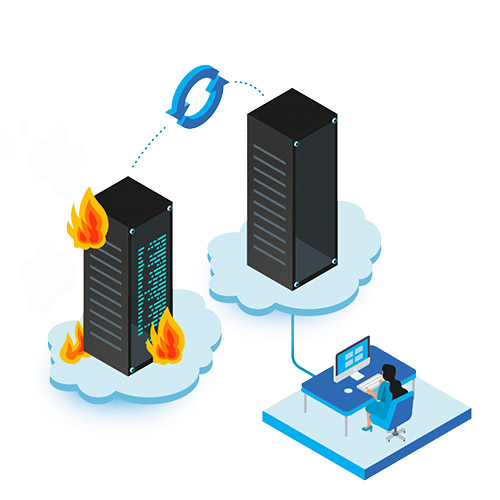How DRaaS Helps Safeguard Your Data in Times of Disaster
 John Highsmith
John Highsmith
In today’s digital world, protecting your data is more important than ever. From natural disasters to cyberattacks, threats can strike at any time, and when they do, your data is often the first thing at risk. This is where Disaster Recovery as a Service (DRaaS) comes in. But what exactly is DRaaS, and how does it help safeguard your data in critical times? Let’s break it down in a way that’s easy to understand.
What Is DRaaS?
Think of DRaaS as a backup plan on steroids. It’s a cloud-based service that ensures your business can continue to run even if your systems go down. With DRaaS, your data is regularly backed up in a secure, off-site location. If disaster strikes, whether it’s a power outage, hardware failure, or something more severe like a flood or cyberattack, DRaaS steps in to restore your systems and get you back up and running quickly.
Why Do You Need DRaaS?
Imagine you’re running a business, and suddenly your servers crash. Your entire operation grinds to a halt, and every minute of downtime is costing you money—not to mention the stress of potentially losing valuable data. DRaaS helps avoid this nightmare scenario by ensuring your data is always safe and recoverable.
Here’s why it matters:
Minimal Downtime: When disaster strikes, DRaaS kicks in to restore your systems as quickly as possible. This keeps your business running and reduces costly downtime.
Data Protection: Since DRaaS continuously backs up your data, even the latest changes to your files are protected. You won’t have to worry about losing hours or days of work.
Peace of Mind: Knowing your data is safe in a secure, off-site location lets you focus on your business instead of disaster recovery plans.
How Does DRaaS Work?
Let’s break it down simply. DRaaS is essentially a combination of cloud computing and disaster recovery. It backs up your critical data and applications to the cloud so that if your physical servers are compromised, you can still access everything you need from a secure, remote location.
Here’s how it works in a disaster scenario:
Your systems go down. Whether it’s a cyberattack, a hardware failure, or a natural disaster, your on-site data becomes unavailable.
DRaaS steps in. With everything backed up in the cloud, DRaaS allows you to switch over to the replicated systems almost immediately. It’s like having a virtual duplicate of your operations ready to take over when needed.
You continue working. Your business stays up and running, and your customers might not even notice there was a problem.
Your data is restored. Once your primary systems are back online, DRaaS helps restore your data so you can resume normal operations without missing a beat.
Real-Life Examples: When DRaaS Saved the Day
It’s one thing to understand how DRaaS works, but let’s take a look at real-world scenarios where it made a difference.
Cyberattack Recovery: A medium-sized company faced a ransomware attack that locked down their servers. Thanks to their DRaaS plan, they were able to switch to their cloud backups within hours, avoiding paying the ransom and resuming operations without losing critical data.
Natural Disaster: During a hurricane, a business’s data center was flooded, but with DRaaS, their cloud backups were untouched. They continued operations remotely, while their physical infrastructure was repaired.
In both cases, DRaaS not only saved valuable data but also kept the businesses running with minimal interruption.
The Benefits of DRaaS for Your Business
Investing in DRaaS is like having insurance for your data—it’s a safeguard that ensures you’re prepared for the unexpected. Here’s why it’s worth considering:
Cost-Effective: Compared to setting up a full in-house disaster recovery system, DRaaS offers a more affordable solution. You don’t need to invest in expensive hardware, and you pay only for the resources you use.
Scalable: Whether you’re a small business or a large enterprise, DRaaS can grow with you. It’s flexible, so you can adjust your storage and recovery needs as your business expands.
Comprehensive Coverage: DRaaS covers all kinds of disasters, from physical damage to cyber threats, ensuring that no matter what happens, your data is protected.
Automated Backups: DRaaS automates the backup process, so you don’t need to worry about manually saving files. It takes care of everything for you.
Final Thoughts
In times of disaster, your data is one of your most valuable assets. Whether you’re dealing with a small glitch or a full-scale crisis, DRaaS helps ensure that your business can keep running smoothly. With the peace of mind that comes from knowing your data is safe and recoverable, you can focus on what really matters: growing your business.
When it comes to safeguarding your data, DRaaS isn’t just a nice-to-have—it’s a must-have. Don’t wait for disaster to strike before realizing how crucial it is to have a plan in place. With DRaaS, you can rest easy knowing that whatever happens, your data—and your business—are protected.
Subscribe to my newsletter
Read articles from John Highsmith directly inside your inbox. Subscribe to the newsletter, and don't miss out.
Written by
